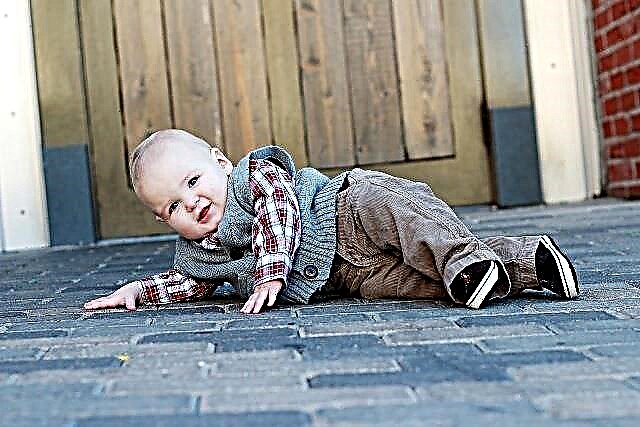The first steps of a baby are an important stage in his development. Moms and dads look forward to when he starts to sit, crawl, walk, talk and strive to actively participate in the acquisition of each new skill by the baby. What could be more normal for a parent than wanting to help their child walk? However, it is important not to be ahead of the curve, as each infant develops at its own pace.

Baby's first steps
Normal age for the first steps
The child does not take the first steps immediately. This happens gradually. At about 8 months old, the toddler begins to rise on its legs. He is able to stand for several seconds.
After a few weeks, the baby learns new movements in a standing position. At first, he only takes lateral steps, which are great exercises for the leg muscles and also develop a sense of balance and coordination. Over time, he finds a balance that allows him to free himself from support and walk, giving his mother both arms, then one. Finally, the day comes when the baby will walk on its own.
Important! The baby takes its first steps between 10 and 20 months. Therefore, each parent should adapt to the pace of development of their baby and not worry that the child does not walk a year.
An early start often inspires mums and dads, but it is not always good for the body. Up to 10 months, joints are weak, bones are flexible, they can be bent by early walking. Therefore, children should not be encouraged to walk as early as possible.
Some children are slow to get started. In this case, you do not need to force them. When the baby's body and brain are fully prepared, he will go.
Experts from the World Health Organization believe that you need to start worrying if the child is already 18-20 months old, and he has not yet walked. This is the age when consultation with a pediatrician and, possibly, examination of the child is necessary.
Reasons for delaying independent steps
There are children who start walking much later than others, although there are no medical problems to explain this delay. The most common reasons why a child does not want to walk yet:
- If the baby began to turn on his tummy much later, if he was still lying when the others were already sitting, and did not move when the majority were crawling, then it will be completely normal if the baby does not walk for 12 months. Obviously, the rhythm of its development is slightly different. The only thing you need to pay attention to is whether this process is too slow. To exclude possible disorders, you need to consult a doctor;
- There are children with a very calm temperament. They can sit or lie in one place for hours, do not seek to get a distant toy, but are content with the one that is closer to them. Naturally, such a situation is likely when the child is one year old, but he does not walk;
- Caution is a character trait in children. Some kids are real explorers. They fearlessly try to crawl, get up and walk when they cannot yet. They can fall, cry, but do not abandon their intentions. Others, on the other hand, are more careful. They are in no hurry to part with the support, they always walk close to furniture and walls, prefer to bend over and crawl than to take the first independent step;
Important! Cautious babies usually take longer to walk on their own, but they have an edge. Such a child falls less, because when he walks on his own, he already has enough strength and a sense of balance.
- Perhaps the baby, when trying to step independently, fell and hit hard. Bad experience made him fearful, and he goes into a group of cautious children;

The kid fell
- Sometimes the anatomical features of babies prevent them from being the first to master independent walking. This happens if they are overweight or if their height affects their sense of balance;
- It often happens that parents give a hand to a baby trying to walk. The child begins to walk using the support point. Some children quickly get used to it, after twelve months or even older they are in no hurry to part with support. They no longer seek the balance and strength needed to walk on their own;
- Sometimes babies who crawl very well do not see any point in walking slowly and uncertainly. If crawling is a quick and convenient way for them to get where they want, why get up, walk slowly, and fall after every few steps.

The kid crawls confidently
How to prepare your child for walking
The child gradually prepares to walk throughout his previous development. His muscles develop, and bones become stronger, motor skills of movements are formed. Each stage plays a significant role in sensorimotor development, body control and the ability to assess one's skills.
Here are some tips for parents on how to prepare the right conditions for teaching the baby the first steps:
- Organize the surrounding space. The external environment should be spacious enough so that the baby can move freely in it;
- Suitable surface. The floor must be sufficiently hard. Wood or linoleum floors make it easy to move around. The tiles are cold and slippery. Therefore, the bathroom and toilet are not suitable places for a baby trying to take his first steps;
- Clothing must be elastic and loose;
- Bare feet are preferable to shod ones. They allow you to use your fingers to maintain balance. You can put socks on your baby, but they can make him slip. Therefore, you need to choose those that have rubber inserts on the sole;
- It is necessary to promote the strengthening and development of the muscles of the baby: at 3-4 months, spread it on the tummy, then encourage independent attempts to roll over from back to stomach;
- The development and strengthening of muscles is well promoted by gymnastics. In total, mothers should devote an hour a day to various exercises and massage. Repulsion workouts strengthen leg muscles well. For example, if a baby is lying on its tummy on a large ball, you can let it push off with its feet, or while taking a bath, let it push off its walls. When playing with the baby, you can put him on his legs, supporting the armpits and encouraging him to imitate jumping;

Ball gymnastics
- More and more pediatricians recognize that the more and more confidently a child crawls, the more useful it is for subsequent walking.
Help your child learn to walk
Parents often forget that the kid must learn to walk on his own, every child is "programmed" for this. The goal of the parents is to do nothing but make this task easier for him and remove obstacles to its solution.
Encouraging a child to explore his surroundings is a great help. All children are curious, and if you organize the space correctly, then babies will have many incentives to explore it:
- it is necessary to remove all dangerous objects (small toys from the floor, which the child can step on; things that can roll over or injure the baby);
- then put bright and interesting toys and objects in different places that can grab the baby's attention, after a while he will learn how to approach them.
Important! Avoid holding the baby by the handle to make him walk. So he takes an unstable, unbalanced position. Better to let him move himself, leaning on the walls, sofas and armchairs. There will come a moment when he independently wants to overcome the space where there is nothing to rely on.

Walking on furniture
At 10 months
Ten month old babies can already be put on their legs, holding them under the armpits with both hands. Children react very actively to funny music and are quite capable of moving rhythmically in this position with the help of their mother, pushing off with their legs. Many will do it on their own, holding onto a support.
At 11 months
If at 11 months the child is not yet walking, you can work with him to strengthen the muscles of the foot, combining play with a useful activity. For example, you can wrap it around the bubble wrap.
In year
When the child is already a year old, he will gladly stomp with his mother on the street, holding one or two hands.
Possible problems
When teaching to walk, parents should be patient and try to avoid misbehaving:
- The ideal position for parents with the support of babies is from behind. This gives the baby a sense of security. In this case, you need to support the child by the arms, but do not try to let him go if he does not want to;

Baby back support
- If the baby is tired of standing, holding on to the support, let him sit down and rest. You cannot force him to be on his feet for a long time;
- Baby walkers are useless and dangerous. It is better to buy big baby cars or carts for the baby, designed to be pushed in front of him. This stimulates children well to move on their feet.

Walking with a baby cart
- Don't speed up the learning process;
- Parents need to remain calm, not nervous, and even more so not to show their fear if the baby falls. Intervene only if it threatens the safety of the infant.
There are many reasons why some children start walking later than others. It is important to know that this is normal in most cases. However, if after 18-20 months the baby still does not walk, you need to go for a consultation with a specialist who can determine if the baby has health problems.



